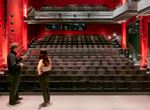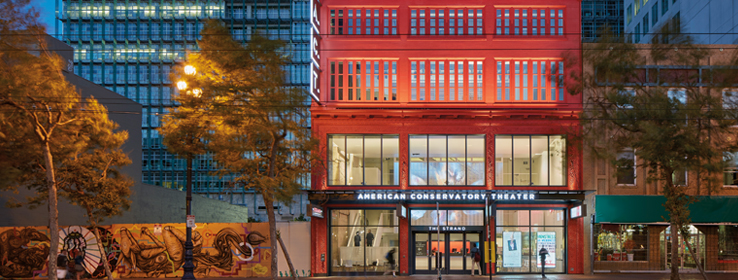What is it about red and San Francisco? Its iconic status for the city starts with the International Orange of the Golden Gate Bridge — which was the inspiration for the remarkable revival of this seedy San Francisco movie palace.
By Alyssa Ford
Just three short years ago, the historic Strand Theater in San Francisco was boarded up, collapsing, occupied by squatters, and littered with broken bottles. The once-grand film house, worn down by years of poverty and decay, was just a breath away from being condemned and swept away at the end of a bulldozer.
But when architect Michael Duncan toured the structure, he saw something far more. “We walked onto the small stage and I thought, ‘My God, this is fantastic,’” says Duncan, design director at the San Francisco office of Skidmore, Owings & Merrill (SOM).
Enlisted by American Conservatory Theater (A.C.T.) to stage the building’s transformation, Duncan immediately saw what had first caught the eye of A.C.T. scouts: The old Strand had incredible bones, wonderful historic details and the ability to unload from the alley right onto stage level, a big plus for stagehands. Duncan set to work remaking The Strand into a second stage for one of the most influential theater companies in the U.S. A.C.T. is an acclaimed institution, its Tony Award–winning Conservatory having trained the likes of Denzel Washington, Annette Bening, Elizabeth Banks, Nicolas Cage, Winona Ryder and Chris Pine.
Glamour to grit and back again, A.C.T. has been a part of San Francisco since the Age of Aquarius, but the history of The Strand goes back much further. When the theater debuted in 1917, The Strand was called The Jewel, so-named for its marquee’s cut-glass rotating ball that scattered reflected light on amazed passersby. Early San Francisco cinephiles sat in plush walnut chairs and took in silent films with live orchestral accompaniment.
In 1929, the theater was one of the first to screen “talkies” in the Bay Area. But as the Market Street area fell into decline, The Strand and other venues along the entertainment corridor grew sketchy. By 1977, the Strand was a grindhouse theater showing all-day B-movies for a buck and midnight screenings of “The Rocky Horror Picture Show.” In 1999, it was converted into an adult theater and, four years later, the San Francisco Police Department closed the place down for good after a narcotics sting.
Duncan shied away from none of it. He had the 1917 decorative grilles and historic cast-stone details restored. Other defining elements were preserved. The previous owner donated the 1959 marquee, now rewired with fresh bands of pink neon. Even some of the graffiti was saved: A backstage wall still says “Junkies for Life” in big, spray-painted letters. Local color, you know.
To ready the 20,000-square-foot Strand for a live theater company, Duncan retained the original footprint but exploded the I-shaped building from the inside out, removing the crumbling onyx staircase and opening the lobby to two full stories. The new jewel is the lobby’s 200-square-foot Luxmax screen made up of 126 individual panels, a rotating mirror ball for the 21st century. Before The Strand, Luxmax LED screens of this size and capability had only been used for high-production concerts such as Justin Bieber, Lady Antebellum and Maroon 5.

One of the most complicated questions was color. Some voices wanted the new theater returned to its historic white or yellow-beige. Duncan was thinking far bolder. He argued for a hue that would pop against the green glass of the Thom Mayne–designed Federal Building, something that would catch eyeballs and, in Duncan’s words, “vibrate at night.” The team created a sexy custom mix that falls somewhere between ruby and mandarin, tinting it slightly darker for inside versus outside.
“I wanted a red that was neither orange nor brick. In my mind it’s kind of a constructivist red,” Duncan says. “I wanted it to be a little racy and vivacious.”
The exterior expression began with Loxon® Concrete & Masonry Primer, which seals, conditions and masks imperfections. Atop the primer went ConFlex™ XL High-Build Elastomeric Coating, which protects from water penetration and will not trap the moisture vapor inside.
According to SOM architect Aaron Jensen, who assisted Duncan, “The gray tint of the ConFlex also significantly improved the color saturation of the final two coats of the custom-tinted Sherwin-Williams Resilience™ (Exterior Paint with Moisture Guard™ technology), which was critical in getting the vibrant red color we were after.” An added benefit: Resilience meets California’s strict exterior VOC requirements.
Inside the Toni Rembe Theater, the zero VOC content and durability of ProMar 200 was appealing. The custom red was tinted just slightly darker for the walls so as not to distract patrons during performances, and a touch less saturated on the ceiling to deflect light bouncing from the stage. The red is its own show.

“When you come in, you’re in this bright white lobby, but as you look ahead, you see a hint of the red on the walls of the box office,” Duncan says. “As you turn the corner — bam! — you’re in this all-red, super-saturated theater.”
Just goes to show: Actors aren’t the only ones with a flair for the dramatic. The once-tawdry Strand has staged a major comeback, thanks in part to its chromatic costume change.
The Golden Gate Feat
A.C.T.’s new playhouse glows red-orange on the inside and out. Artistic Director Carey Perloff says she was won over by the custom cinnabar hue — informally dubbed “A.C.T. Red” — because it reminded her of the rich vermilion on the Golden Gate Bridge. “That color is very San Francisco,” Perloff says.
The famous landmark is painted “Golden Gate Bridge International Orange,” architect Irving Morrow’s pick to contrast with the Marin headlands’ ochre and the Golden Gate Strait’s sun-dappled waters.
The Golden Gate Bridge, Highway and Transportation District received so many requests for the paint color that it finally posted the formula on its website: 0 percent Cyan, 69 percent Magenta, 100 percent Yellow and 6 percent Black. The bridge captain generally suggests people just go for Sherwin-Williams Fireweed (SW 6328), the closest off-the-shelf color. To keep the bridge in saturated style, an army of 28 painters, five painter-laborers and a chief continuously repaint the massive structure, using up to 10,000 gallons of Sherwin-Williams coatings each year to touch up 10 million square feet of steel and 1.7 miles of cable. The paint is mixed off-site and shipped to the bridge as needed.
San Fran Color
A.C.T.’s Strand Theater isn’t the only place in The Bay inspired by the Golden Gate Bridge’s hue.
The International Orange House, a funky residence in the Bernal Heights neighborhood, is owned by Golden Gate Bridge enthusiast Todd Lappin. He painted his entire exterior in Sherwin-Williams Fireweed (SW 6328)
Glassybaby, a glass studio and hot shop in the Madrona neighborhood, sells an International Orange votive, with 10 percent of the profits going to San Francisco charities.
California-based nail polish company OPI noted the bridge’s 75th anniversary in 2013 with a vibrant red-orange shade dubbed “Hot Date at the Golden Gate.”
California-based nail polish company OPI noted the bridge’s 75th anniversary in 2013 with a vibrant red-orange shade dubbed “Hot Date at the Golden Gate.”
A look inside The Strand:
COLOR:

Select interior walls and trim:
COATINGS:
Exterior (stucco):
Loxon® Concrete & Masonry Primer
ConFlex™ XL High-Build Coating
Resilience® Exterior Acrylic Latex
Interior Walls:
ProMar® 200 Zero VOC Interior Latex Paint
Interior Metal Finishes:
Pro Industrial™ Pro-Cryl® Universal Acrylic Primer
Sher-Cryl™ High Performance Acrylic
This article originally ran in the 2016 STIR Special Issue.









